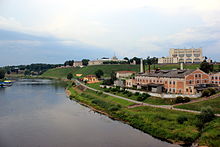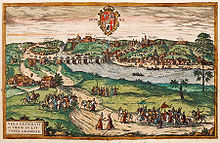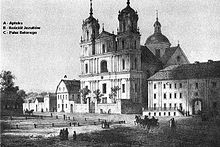Grodno
![]()
Grodno is a redirect to this article. For the castle in Lower Silesia, see Grodno Castle.
Hrodna resp. Grodno (Belarusian Гродна Hrodna; Russian Гродно Grodno; Polish Grodno, Lithuanian Gardinas; older Belarusian Горадня Horadnja or Гародня Harodnja; Yiddish גראָדנע Grodne; German veraltet Garten) is a town in Belarus on the Memel River, near the border triangle with Poland and Lithuania. It is the administrative seat of the Hrodzenskaya Voblasts and the Hrodna Rajon.
With a population of around 380,000 (as of 2018/19), it is the fifth largest city in Belarus. From 1919 to 1939, Hrodna belonged to Poland and had a Polish-speaking majority population consisting of Jews and Poles. As a result of border shifts instigated by Stalin, the town fell to the Soviet Union, and large parts of the Polish population were expelled, with Russians and Belarusians from other parts of the country settling there instead. Since 1991, the city has been part of independent Belarus; to this day, there is still a strong Polish minority there. Hrodna is a twin town of Minden in Westphalia, of Białystok and Wroclaw in Poland, of Limoges in France and of Alytus in Lithuania.
Coat of arms
Description: In blue, a brown stag with a gold Latin cross between its antlers leaps over a silver wattle fence.
History
Hrodna was first mentioned in 1128 as a castle complex under the name Goroden in the Polotsk Principality in the Rus Union. The name is related to the Slavic word Grad and means something like "fortified settlement". Some time later it became the centre of an independent Old Russian principality, which subsequently lost its independence to the Grand Duchy of Lithuania. Hrodna received its town charter from the Lithuanian prince Vytautas in 1391. The prince also donated the parish church to the town and had two of three castles located here expanded.
After the Battle of Tannenberg, the town quickly flourished from 1410 onwards, expanding territorially. Hrodna was ruled by two mayors, one Catholic and one Orthodox. The town experienced its golden age during the reign of the Jagiellonian and Wasa dynasties. During the time of Stefan Batory, Hrodna became the de facto capital of the Polish-Lithuanian Empire. The old castle was expanded at that time, a Jesuit school was established. Hrodna was the seat of the Crown Tribunal, the highest court for the territories of the Grand Duchy of Lithuania.
Bad times for Hrodna dawned with the so-called "Swedish tide". In 1705, Russian troops were trapped by Swedish troops near Hrodna, but were able to successfully retreat in March 1706 without a military clash. Under King August III, the New Castle was built from 1737 to 1742 as a meeting place for the Polish-Lithuanian Sejm. Under the reign of Stanisław August Poniatowski, Lithuania's first playhouse was built, and the last Polish king founded several schools.
Since 1776 the weekly newspaper "Gazeta Grodzieńska" (Grodno Newspaper) and "Rocznik Gospodarczy" (Economic Yearbook) were published.
In 1793, the city hosted the last Sejm, where the second partition of Poland was ratified. Two years later the city came under Russian rule and in 1802 became the seat of the Russian governor for the Grodno Governorate. Occupied by Napoleonic troops in 1812, it fell back under Russian control a few months later.
After the November Uprising of 1830/31, the Polish inhabitants of the city were subjected to repression. The tsar had the Greek Catholic rite banned, Roman Catholic monasteries were liquidated step by step. The public use of the Polish language was banned.
In 1862 the Petersburg-Warsaw railway was built, on which Hrodna has a station. This connection is only used in the direction of Poland, the line towards Russia has been interrupted since 2004.
In 1863 the majority of the inhabitants took part in the January Uprising against Tsar Alexander II.
The city was an important Jewish center, around 1900 about 50% of the inhabitants were Jews.
From 1915 to 1919 the town was occupied by German troops, in the spring of 1919 it was annexed to the re-established Poland and became a district town in the Białystok Voivodeship. Jews made up the majority of the town's population. Catholic and Orthodox Christians also lived in the town, the majority of whom considered themselves Polish. In the surrounding villages lived both Poles and Belarusians, in the north also Lithuanians.
In the interwar period, despite economic difficulties, the city became the cultural center of the region: the Drama House, named after Eliza Orzeszkowa, was opened, historical and geological museums and a zoo were built. Grodno was the seat of a large military garrison. From 1930 new houses in the style of constructivism were again built in Grodno. Many of them were built in regional timber construction in new quarters on the outskirts of the city and are now threatened with demolition.
On September 21, 1939, the city was occupied in the course of the Soviet invasion of Poland. Grodno was the only locality in what was then eastern Poland to resist the Red Army. On November 2, the town was annexed to Belarus and became a rayon town in Białystok Oblast. In February, April, June 1940 and February 1941, many Polish residents of Hrodna, who were classified as class enemies, were deported to Siberia and Kazakhstan by the Soviet occupation.
From June 1941 to July 1944, the city was occupied by the German Wehrmacht. Formally, the Białystok district was annexed to East Prussia, but it remained a separate administrative unit. Gestapo structures were established in Białystok from Allenstein, which organized the surveillance of the population in Grodno as well as the murder of the Grodno Jews. From November 1, 1941, the Jews of the city were moved to two ghettos in the center of the city, from where more than 20,000 people were deported to the temporary camp or directly to the extermination camps Treblinka or Auschwitz-Birkenau, where almost all of them were murdered.
In the Treaty of August 16, 1945, the Polish Communist government accepted the new border along the Curzon Line. The majority of Hrodna's Polish population was expelled to Poland, where they settled in the former German eastern territories (including East Prussia, Silesia) and in central Poland. After 1945, in addition to Soviet cadres from the east of the BSSR and the interior of the Soviet Union, Orthodox and Catholic peasants from the surrounding area migrated to Hrodna. As a result, since the end of the 1950s there were already officially more Poles and Belarusians living in Grodno than before 1939.
Since the dissolution of the Soviet Union, the city has belonged to independent Belarus since 1991 and is the administrative seat of the Hrodzenskaya Voblasts.
On December 19, 2008, Vice-government head Vladimir Semashko announced in Minsk that the site of the first Belarusian nuclear power plant would be located on the territory of Hrodzenskaya Voblasts. Construction was supposed to begin as early as 2009. However, it was only in 2012 that a framework construction agreement was signed between the Minsk government and Russia's NIAEP JSC - the management company of Atomstroiexport JSC (ASE) - for the construction of two reactor units of the Russian AES-2006 series. The first unit has been under construction since 2013. It was scheduled to go online in 2018, and the second unit in 2020. The nuclear power plant officially went online with its first unit on November 7, 2020.
In September 2012, the construction of Belarus' largest hydropower plant in Grodno, which began in 2008, was completed.

View over the Memel to the Old and New Castle

Town view around 1575

Market with Franz-Xaver-Cathedral around 1860
Search within the encyclopedia